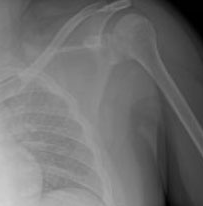Lesser Tubercle of humerus Definition, Function, Palpation, Attachments
A major component of the human skeletal system is the humerus, or upper arm bone. The humerus contains a number of anatomical locations with distinct roles. The lesser tubercle of the humerus is one of these locations, and it is critical to the normal functioning of the shoulder joint.
Lesser Tubercle of humerus Anatomy
The ball-shaped humerus head attaches to the scapula socket to form the shoulder joint. The neck is the narrow area below the head where ligaments and tendons attach. The greater tubercle is on the lateral side of the humerus, whereas the lesser is on the anterior side.
Lesser Tubercle of humerus Definition
The lesser tubercle is a small, smooth, muscular prominence seen in front of the anatomical neck. The lateral portion creates the intertubercular sulcus' medial edge. This tubercle serves as an attachment site for the subscapularis muscle and the transverse ligament of the shoulder.

Lesser Tubercle of humerus Function
The lesser tubercle contributes significantly to the shoulder joint's functionality. It functions as a point of attachment for the muscles necessary for the shoulder's stability, adduction, and internal rotation. These movements, as well as the shoulder's overall range of motion and stability, would be hindered without the lesser tubercle.
Lesser Tubercle of humerus Palpation
Preparing the patient and setting up a good examination environment are crucial before doing lesser tubercle palpation. Explain the process to the patient, get his permission, and make sure his privacy is protected. Expose the patient's upper arm and shoulder region while positioning him comfortably.
Patient Positioning
Place the patient in a seated or prone posture, with the elbow bent to 90 degrees and the arm at rest.
To maintain a steady stance, give the forearm enough support.
Find the Landmarks
Find the bony protrusion on the shoulder known as the acromion process.
Look for the coracoid process, a hook-shaped structure next to the acromion process.
The lesser tubercle is located medial to the coracoid process on the anterior aspect of the humerus.
Identifying the Lesser Tubercle
Put your fingers just medial to the coracoid process on the shoulder's anterior side.
Locate the lesser tubercle by gently palpating the region and feeling for a bony protrusion.
During the palpation process, make note of any tenderness, swelling, or abnormalities.
Assessing Range of Motion
Examine the patient's shoulder joint range of motion after palpating the lesser tubercle.
As you move actively or passively, look out for any restrictions, pain, or discomfort.
Lesser Tubercle of humerus Attachments
The arm bone is called the humerus. The superior extremity of the humerus holds the greater and lesser tubercles. The greater tubercle is lateral in position and has three noticeable facets. The subscapularis, a primary adductor of the arm at the shoulder, inserts into the lesser tubercle of the humerus. It aids in preventing arm dislocation at the shoulder.
 Reviewed by Simon Albert
on
May 26, 2023
Rating:
Reviewed by Simon Albert
on
May 26, 2023
Rating:











